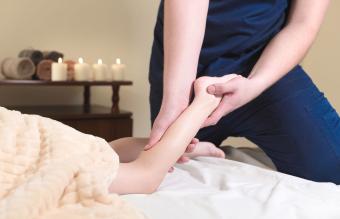
Some people believe that growing pains in kids are a myth, but Dr. Emily Pittman, a pediatric hospitalist with Riley Children's Health, shares that these pains are real. Knowing what causes growing pains, how to tell if your child has them, and how to relieve your child's growing pains can help you both be more comfortable.
What Are Growing Pains in Kids?
"Growing pain are episodic musculoskeletal pain in children," says Dr. Pittman. They go away without any treatment and generally cause pain when a child is asleep.
- Anywhere from 3% to 33% of children suffer from growing pains.
- Growing pains typically present in kids ages 3 to 12, but they can last all the way into adolescence.
- Girls tend to report growing pains slightly more than boys do.
Causes of Children's Growing Pains
No one knows for sure what causes growing pains because they surprisingly, "do not happen when children are at the age that they are going through large growth spurts," shares Dr. Pittman. Some possible causes of growing pains include:
- Fatigue
- Mild orthopedic and postural abnormalities
- Hypermobility
- Overuse of legs or arms
- Restless leg syndrome
How to Tell if a Child has Growing Pains
There are no specific tests to diagnose growing pains in a child. According to Dr. Pittman, "The diagnosis is suspected when an otherwise healthy child remains pain free during the day and has a normal general physical and musculoskeletal exam." The best way to know if your child's pain can be attributed to growing pains is to visit his or her pediatrician or family doctor.
Symptoms of Growing Pains in Kids
According to Dr. Pittman, "Growing pains are more frequently described in the legs compared with the arms."
- Leg pain associated with growing pains often occurs in both legs at the same time, in the thighs or calves, and can be severe.
- Leg pains often occur night after night and after a child has had an active day.
- Some kids might have pain in all their extremities while others might only complain of dual leg pain or dual arm pain.
- About one in three kids with growing pains will also experience abdominal pain or headaches with their extremity pain.
When to Be Concerned About Pain
If your child's pain doesn't seem to fit exactly with the symptoms of growing pains or includes an obvious leg injury, there may be a different cause. While it's not common, some of these pains could be symptomatic of other more severe problems like juvenile idiopathic arthritis or child cancer. Check with your child's doctor if any of the following are true for your child:
- Pain is only felt in one leg
- A bump or mass on the leg near the area of pain
- Tenderness when pressure is applied
- The child appears ill
- Pain persists during the day or with physical activity
- Pain worsens or persists
- Child has a fever or systematic inflammation
Pain Management and Relief for Kids' Growing Pains
If you're not sure what you can give your child for pain management, consult with their doctor before trying anything. "Options for growing pain relief will vary by child," shares Dr. Pittman, but some of the main pain relief methods that work are:
- Ibuprofen or acetaminophen made for kids - Dosing instructions are provided on the label.
- Massage the affected area - Use one or two hands to gently rub the area with minimal pressure.
- Apply a warm compress to the affected area - Soak a washcloth in warm water then wring out the water and lay over the area.

Growing Up Is Hard
Despite the lack of knowledge on why they occur, growing pains can be a real problem for many kids. Teach your child from a young age to tell you about any pains they have and take their complaints seriously. If you're not sure exactly what is causing your child's pain, you may find after consulting their doctor that it's just growing pains.







